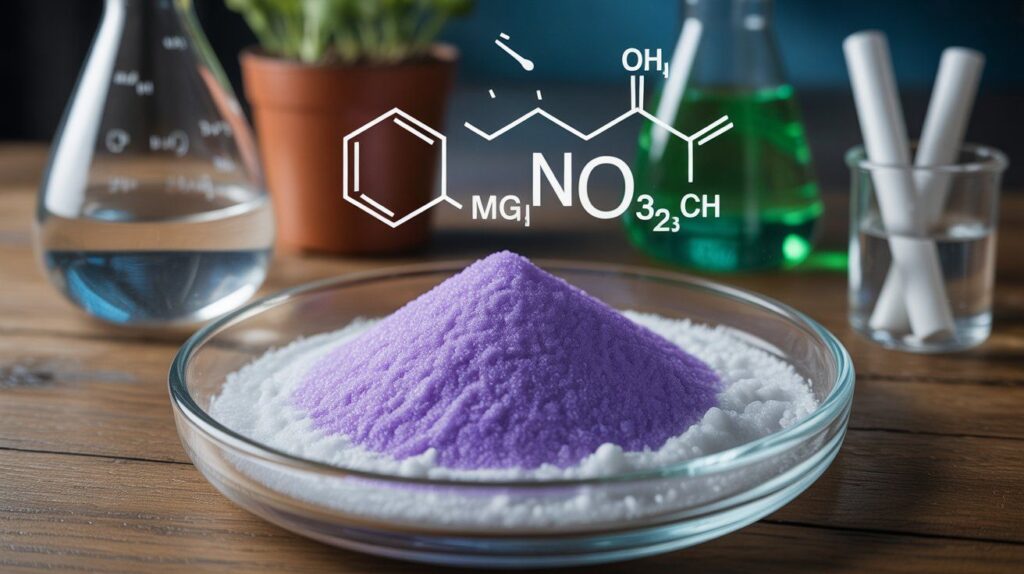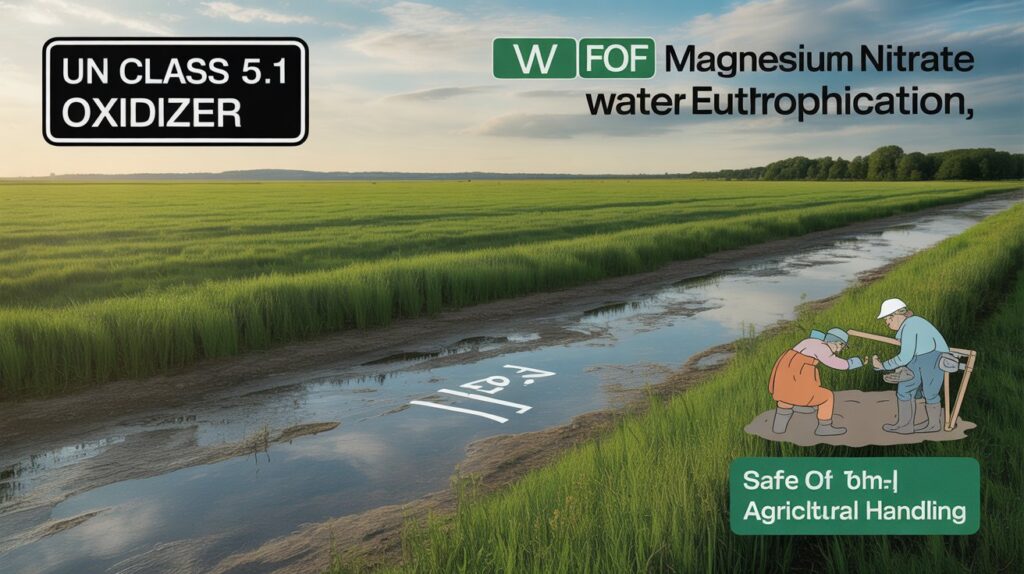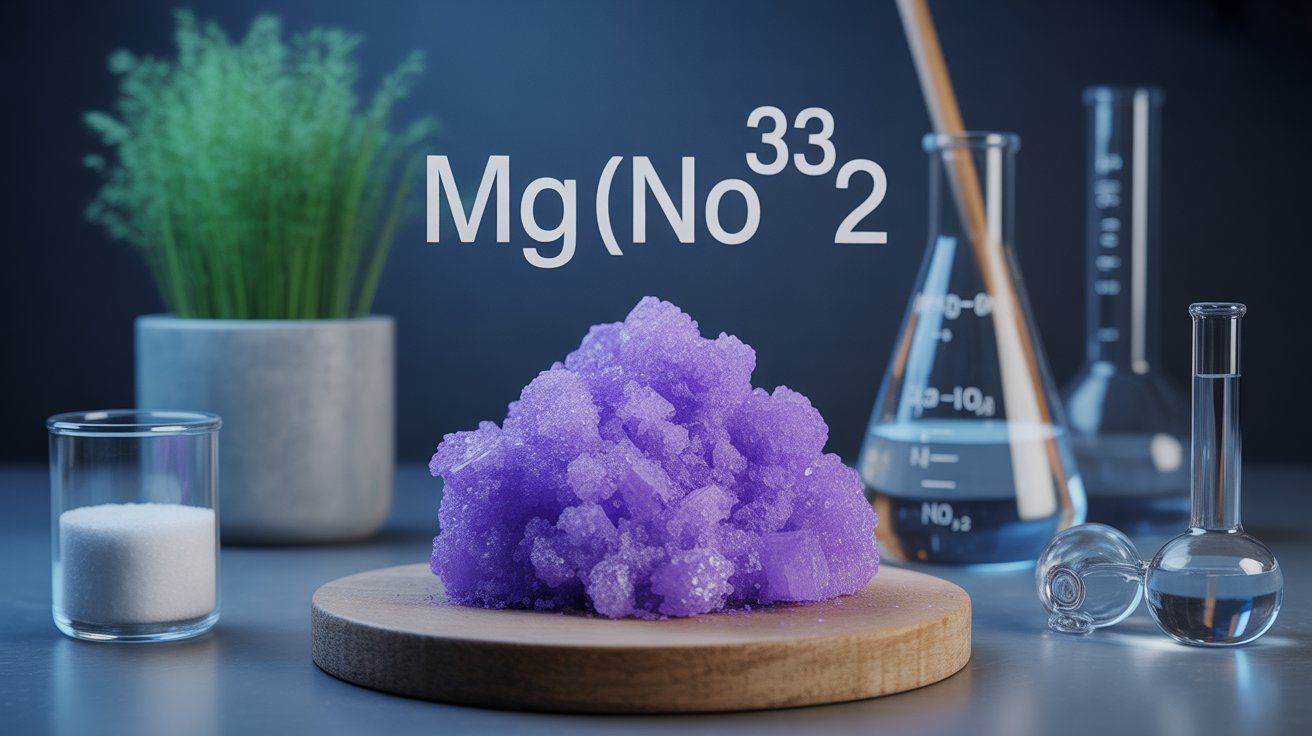Magnesium nitrate is a soluble oxidizer used in fertilizers, hydroponics, labs, and industry, offering key nutrients but requiring careful handling and storage.
Magnesium nitrate
Magnesium nitrate (Mg(NO₃)₂) is a water-soluble nitrate salt of magnesium used in fertilizers, hydroponics, laboratories, and industry. It provides both nitrate nitrogen and magnesium, vital for plant growth and chlorophyll formation.
Found commonly as the hexahydrate, it is highly hygroscopic and functions as an oxidizer, dehydrating agent, and catalyst precursor. Versatile yet regulated, magnesium nitrate demands careful handling to maximize agricultural and industrial benefits while minimizing risks

Safety, Hazards & Handling of Magnesium Nitrate
| Aspect | Details |
|---|---|
| Classification | Oxidizer (UN Class 5.1); intensifies fire risk |
| Health Hazards | Irritates skin, eyes, and respiratory tract; harmful if swallowed |
| Protective Gear | Use gloves, goggles, lab coat, and ensure proper ventilation |
| Storage | Keep in sealed containers, in a cool, dry place, away from heat sources |
| Handling | Avoid contact with combustibles and reducing agents; handle with care |
| Transport | Follow regulations for oxidizers; store separately from flammable materials |
Chemical & Physical Properties
Magnesium nitrate (Mg(NO₃)₂) is a colorless, crystalline, and highly water-soluble salt. Commonly found as the hexahydrate, it is hygroscopic and deliquescent, requiring airtight storage.
It decomposes above 330 °C, releasing MgO, NO₂, and O₂, which explains its role as an oxidizer.
With a molecular weight of 148.32 g/mol (anhydrous), it dissolves rapidly in water, making it especially valuable in fertilizers, hydroponics, and laboratory applications.
Synthesis & Production
Magnesium nitrate is produced by reacting magnesium carbonate or magnesium oxide with nitric acid, yielding highly soluble crystalline salts. Industrial processes favor the hexahydrate form, obtained through controlled crystallization.
In nature, it occurs rarely as nitromagnesite. Purity levels vary by application, with fertilizer, technical, and reagent grades tailored for agriculture, laboratories, and specialized industrial use.
Applications & Uses
Magnesium nitrate serves as both a fertilizer and a hydroponic nutrient, supplying plants with essential magnesium and nitrate nitrogen.
Industrially, it functions as an oxidizer in pyrotechnics, a catalyst precursor, and a dehydrating agent. Laboratories use it for nitric acid concentration and chemical synthesis.
Its high solubility and dual nutrient role make it especially valuable in agriculture.
Reactions & Chemical Behavior
Magnesium nitrate decomposes above 330 °C, releasing MgO, NO₂, and O₂, showing its role as a strong oxidizer.
In aqueous solution, it dissociates fully into magnesium and nitrate ions, making it highly reactive.
With bases, it forms magnesium hydroxide, while contact with reducing agents or combustibles can trigger hazardous reactions, underscoring the need for careful handling and storage.
Environmental & Regulatory Aspects
Magnesium nitrate contributes to nitrate runoff, which may cause eutrophication in water systems. Because it is an oxidizing agent, transport and storage are regulated under UN Class 5.1. Environmental guidelines require controlled application in agriculture to reduce pollution risks.
Compliance with international regulations and local safety standards ensures its safe use across farming, laboratory, and industrial settings.

Analytical Methods & Quality Control
Magnesium nitrate purity is verified through titration, spectroscopic analysis, and gravimetric methods. Fertilizer-grade material is tested for nitrate concentration and magnesium content, ensuring consistent nutrient delivery.
Reagent and industrial grades demand stricter quality control, with impurities monitored closely.
Standardized testing protocols help maintain product reliability, safety, and compliance across agricultural, laboratory, and industrial applications.
FAQs
Q1. What is magnesium nitrate used for?
Mainly in fertilizers, hydroponics, pyrotechnics, and as a reagent.
Q2. Is magnesium nitrate safe?
Yes, with precautions. It is an oxidizer and irritant, so use PPE and avoid combustibles.
Q3. How soluble is it?
Highly soluble in water and ethanol, ideal for nutrient solutions.
Q4. What happens on decomposition?
Above 330 °C, it releases MgO, NO₂, and O₂.
Q5. Can it be used in hydroponics?
Yes, provides magnesium and nitrate nitrogen.
Q6. Hexahydrate vs. dihydrate?
Hexahydrate is common and highly soluble; dihydrate is less frequent.

Hamid Raza, aged 65, is a seasoned expert in nutrition, health supplements, and wellness, with over four decades of experience researching and educating people about essential minerals like magnesium. His work focuses on helping individuals improve energy, bone health, muscle function, and overall wellness through scientifically-backed magnesium knowledge.
Throughout his career, Hamid has contributed to numerous health articles, research studies, and wellness blogs, making complex nutritional science accessible to everyday readers. Passionate about natural health solutions, he guides readers on choosing the right magnesium supplements for optimal health.


